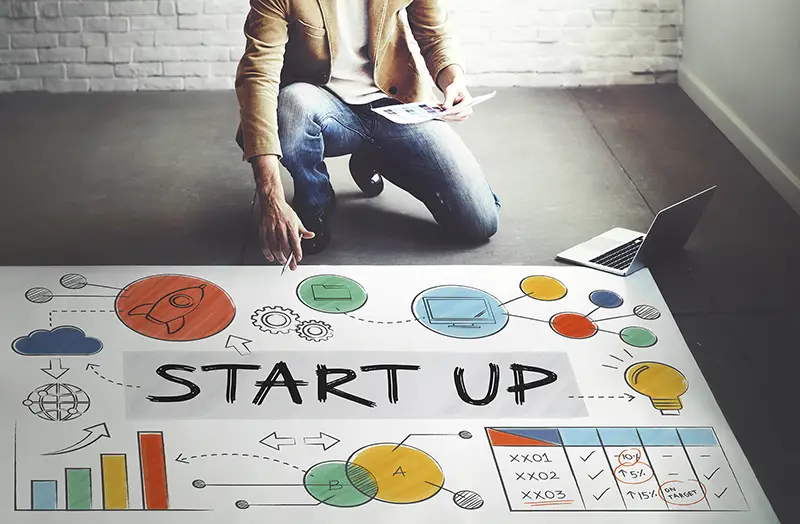Click here to get this post in PDF
Startups are often faced with a dilemma when it comes to choosing a methodology for their projects. Some prefer the waterfall approach, while others consider an agile approach. Which one is right for your startup? The answer may be different depending on what stage you are in as well as your specific needs and resources available. In this post, we will go over the key differences between these two methods so that you can make an informed decision about which method would work best for you!
The waterfall method is a linear, sequential process. Startups using this methodology typically begin with the requirements gathering stage and then move on to design before development begins. Once the product has been created, it moves through various testing phases. Finally, after all of these steps have been completed, it reaches the customer.
The agile methodology is a cyclical process that isn’t afraid to repeat the development/testing stages. The agile methodology emphasizes teamwork, customer satisfaction, and a working product over strict adherence to plans and product design parameters.
Each methodology has its strengths and weaknesses. For decades, the linear approach was viewed as the correct one; the agile method of software development didn’t formally emerge until the early 2000s.
In this post, we’ll break down the core components of each approach and highlight the prevailing views of each.
Core components: waterfall vs. agile
Waterfall:
In this methodology, a set of predefined stages are followed in order to create the product. The customer is not directly involved until late in the process, although there are ample stages that focus on product research, customer research, etc. In fact, this approach generally starts with analysis (exploring issues, gathering requirements) and design before moving into development, testing and finally deployment.
Agile:
This approach is much more diverse in its implementation; it encourages teams to focus on delivering incremental products that meet customer needs early on rather than waiting for the entire product vision to be finalized before starting production. It also allows a team of experts from different disciplines (business analysts, developers and marketers) to work closely together. In fact, one of the hallmarks of the agile approach is its emphasis on teamwork and collaboration.
The key difference
The big difference is how each methodology handles change.
In a linear approach like Waterfall, you’ll have to go back through all of your stages in order to make any changes that come up during the development/testing phases. In other words, a failure at later stages requires a re-evaluation of earlier ones and can risk restarting the entire process.
With agile, change is expected.
Agile teams get together frequently to assess how the project is going and make adjustments as needed. This process of incremental refinements can help teams tweak their plans without having to completely rethink and restructure them from scratch.
In a nutshell, waterfall offers more control but at the cost of flexibility; agile prioritizes flexibility but sacrifices structure and tight control of the project.
Waterfall vs. agile: the dilemma for startups
What’s a modern-day startup to do? Lay out a clear path to the proposed product, implement tight controls over everything, and deliver the best, most polished product possible at the end of it? Or opt for max versatility, recruit a team of free-thinking creatives and developers, and focus on bringing a customer-oriented product to the market ASAP?
In many cases, the deciding factor isn’t what each approach can do, but the risks inherent in each. The waterfall methodology offers more control over the project, but at the expense of flexibility. In a nutshell, this means that if things don’t go as planned for whatever reason (e.g., budget constraints), teams will have to completely rethink and restructure their plans from scratch – which can be time-consuming and very costly. In contrast, the agile approach offers more versatility and agility – but without full control over everything.
The choice between these two approaches is ultimately a trade-off between risk and reward. For example, if you’re building something entirely new from scratch with your team of creatives, it’s probably best to opt for an agile methodology that maximizes adaptability and prioritizes product delivery. For a startup, that offers the chance to show investors and potential customers something concrete fairly early in the process.
Likewise, the agile methodology is likely a better option for startups who are prioritizing speed. It’s more effective in identifying risks early on while also fostering creativity among employees who work with minimal oversight or direction from management. If you’re seeking to rapidly iterate your product as customer feedback rolls in, this method can ensure a greater chance at success.
For larger, more established startups, or for ones seeking to deliver a more complicated product with unusual requirements, the waterfall method provides full control over everything from start to finish. For this reason, some startups favor waterfall for its ability to offer predictability in planning. That predictability is something that many investors look for in startups. Delivering a complete plan for success through the waterfall method can also be a powerful tool for pitching your business to potential investors.
Regardless of the method you choose, it’s important that you and your team are aligned on which one is best suited for what you’re trying to accomplish together as well as how much control everyone has in making decisions during the process. That way, when challenges inevitably arise, both you and your team are best positioned to deal with the problems and deliver results – regardless of the methodology.
You may also like: Agile V Waterfall: Pros and Cons
Image source: Shutterstock.com

